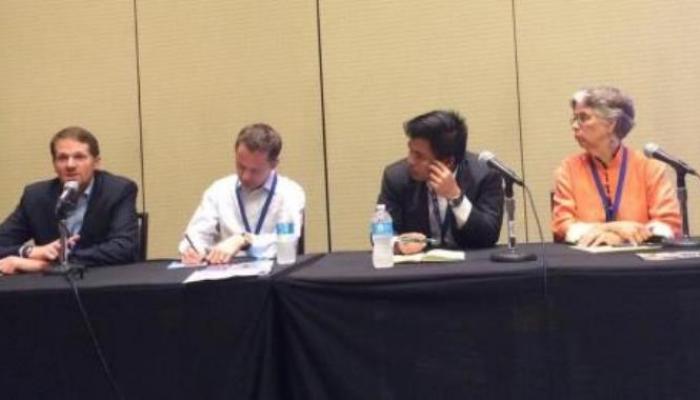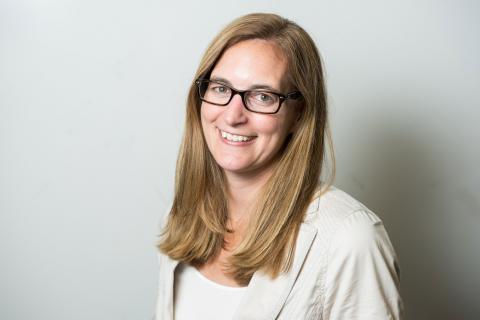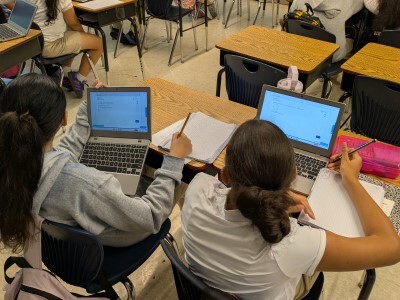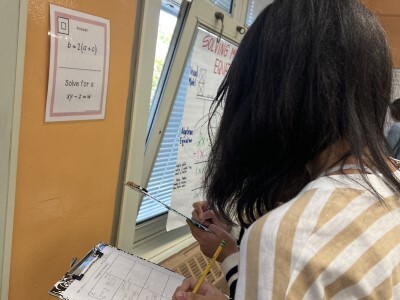Lessons for Launching a Breakthrough Model School
Topics

We’ve all had the experience of truly purposeful, authentic learning and know how valuable it is. Educators are taking the best of what we know about learning, student support, effective instruction, and interpersonal skill-building to completely reimagine schools so that students experience that kind of purposeful learning all day, every day.
Four leaders of NGLC-funded breakthrough schools share lessons learned from their first year launch.
At last week’s iNACOL conference, four leaders of NGLC-funded breakthrough schools shared lessons learned from their Year One launch of a new personalized, competency-based, blended learning school. The panel included Louise Waters of Leadership Public Schools, Oliver Sicat of USC Hybrid High, Tom Willis of Cornerstone Charter Schools, and John Glover of Alpha Public Schools.

Here is a summary of their collective observations:
- Culture matters. As John Glover said, “Culture drives achievement.” A new school brings a great opportunity to create a culture of high-expectations for all students and establish routines, traditions, and supportive ways of interacting with others. But learning in a breakthrough school is new and different not just for students but also for teachers, staff, and families. That means that you have to attend to culture explicitly. And that takes time.
- Lower your expectations on technology software. The approach to software differed across the four schools, but the panelists were consistent in advising others to be careful. Cornerstone outsourced their technology because they wanted to pay more attention to other elements of launching a new school (like culture). USC Hybrid High put all their eggs in one content provider but found that their teachers were customizing the content a great deal. They changed course to give teachers greater choice in software they use and to make the school more nimble to change apps and software quickly if needed. Leadership didn’t even use content software in their first year and instead focused on the Google suite of tools as well as data tools that were not content-driven. Similar to Cornerstone, they wanted to get other pieces of their model right first and let their model drive their technology choices.
- Raise your expectations on the need for data. Data drives decisions in and out of the classroom in these personalized learning environments. But real-time data weren’t always easy to get in an actionable form for teachers and students for these panelists. They therefore found formative and interim assessments extremely helpful in understanding students’ progress. But now Leadership and USC Hybrid High are finding that the interim assessments are constraining student’s ability to move at their own pace in a competency-based learning environment. So they are looking at how to balance the need for data with a need for flexibility in a competency-based model.
- Lower your expectations on partnerships. Connections to community organizations, businesses, and local colleges open up worlds of learning opportunities for students. But they are tricky to manage in a long-term sustainable way. Panelists found that the turnover in leadership in civic, community, and college partners can be high. For instance, a local community college presidency changed hands twice in fourteen months forcing Leadership to continually restart the early college partnership they had established. Tom Willis recommends that you work at the grassroots level to establish relationships in order to access resources, make meaningful connections, and create a partnership that will last.
- Raise your expectations on the amount of time, guidance, and support that you provide new blended learning teachers. There is no blended learning teacher pipeline. (Oliver Sicat did mention that his school is talking with USC about changing that.) New teachers need to learn how to manage their classrooms, engage students in learning, plan lessons, and understand the local community and who the students are. And then they need to learn how to do that in a blended learning classroom. John Glover compared it to doing a handstand in a canoe. Each panelist suggested hiring teaching staff based on their mindset, flexibility, willingness to try new things, and a passion to change education because they are sick of the way schooling has always been done. Training at the start of school is important, but you have to invest in ongoing professional development. Once a teacher spends a week or two with students, they will come back to a training session with much more sophisticated questions and greater insight into their needs.
To learn more about the four schools launched in 2012 by the panelists, visit these links:
- Oakland R&D Campus, Leadership Public Schools – Louise Waters
- Cornerstone Charter Health High School, Cornerstone Public Schools – Tom Willis
- USC Hybrid High School – Oliver Sicat
- Blanca Alvarado Middle School, Alpha Public Schools – John Glover




